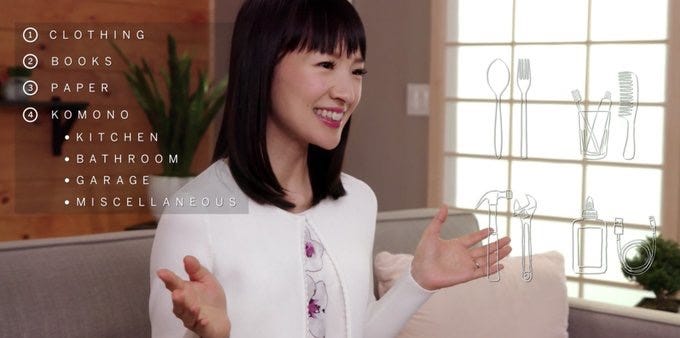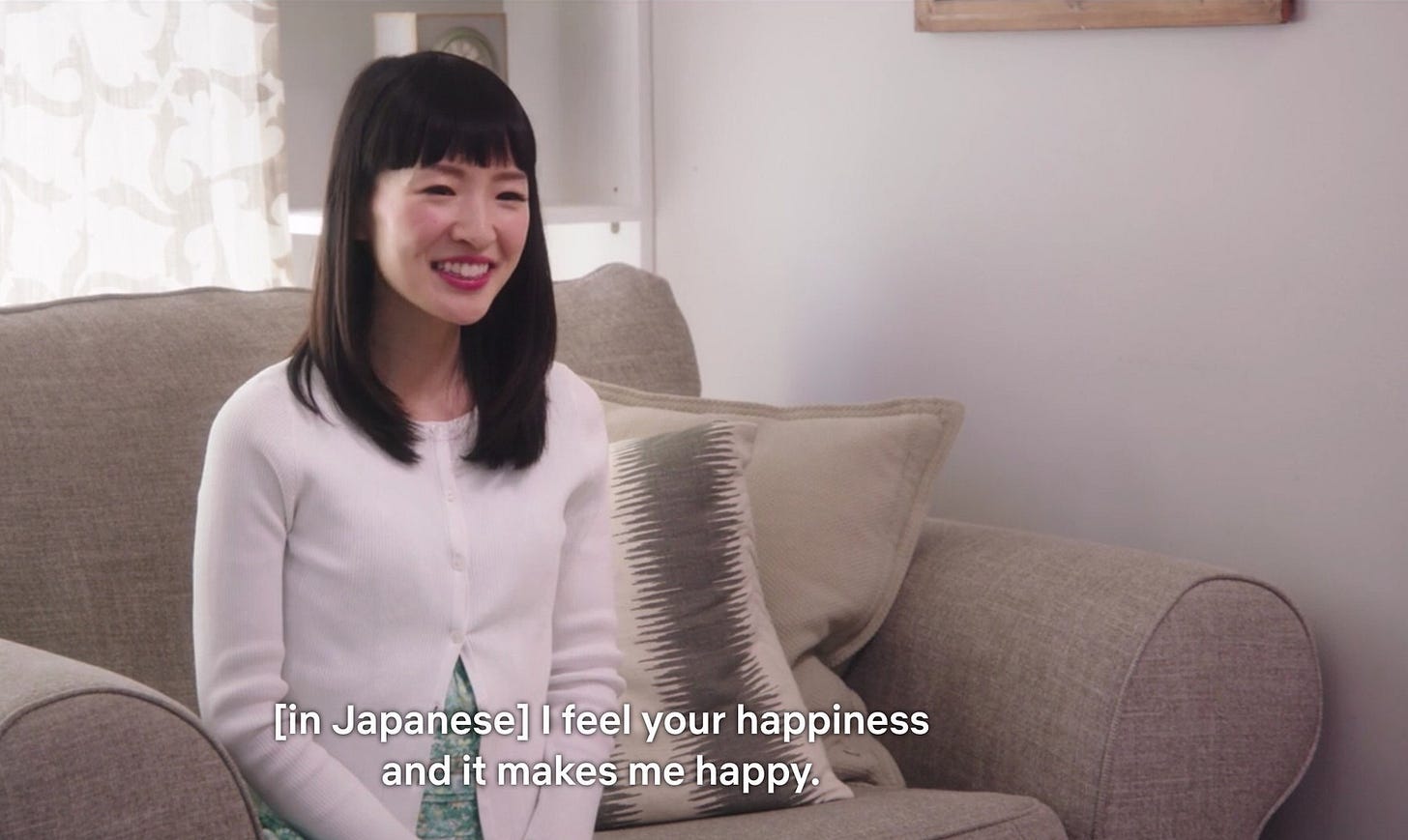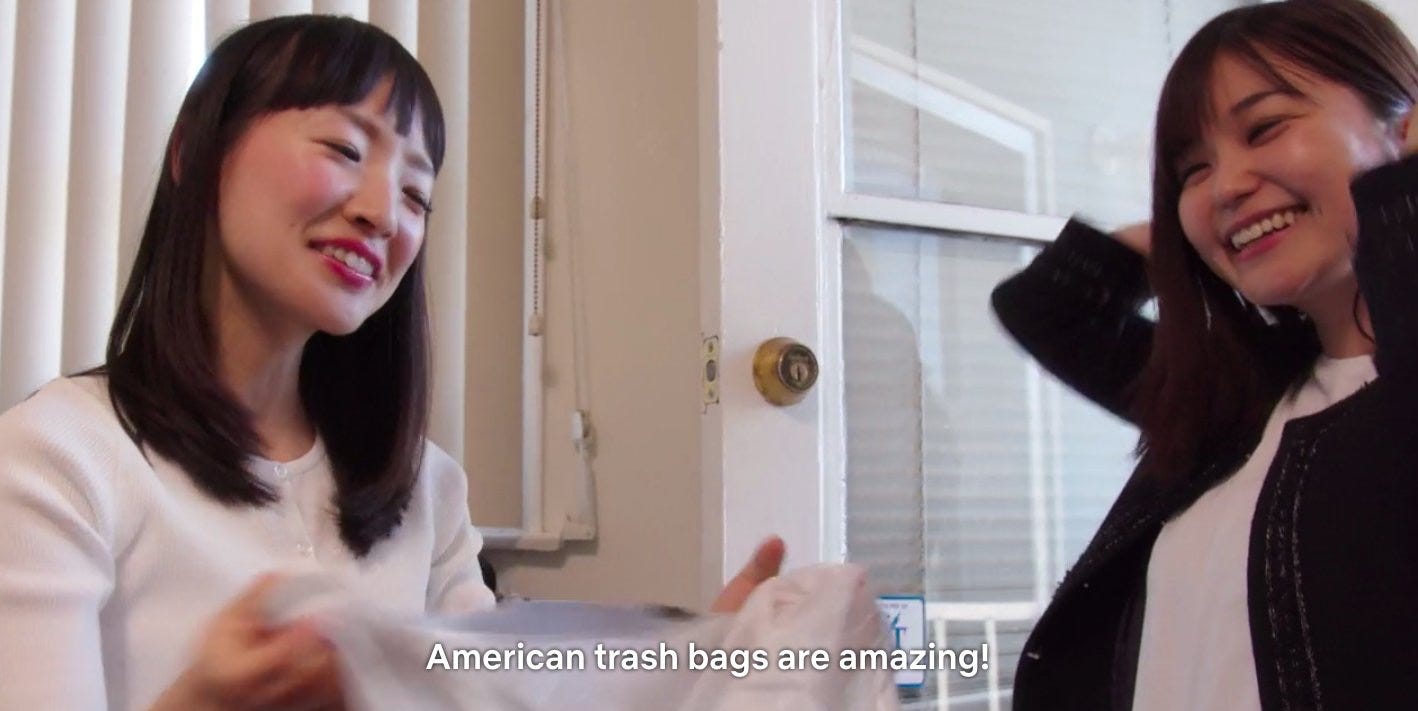'Tidying Up with Marie Kondo' Soothes, Sears, and Self-Actualizes
My 2019 New Year’s resolutions now include: tidying up and never ever calling anyone "babe" ever, ever again

The most commonly used subtitle in Netflix's Tidying Up With Marie Kondo is “[peaceful music playing].”
It pops up on the screen multiple times throughout any episode to score various tidying montages, but my very favorite peaceful music plays when Marie Kondo kneels down on the ground to greet each house she enters. Reader, I cry every single time this woman puts her playing-card-sized-hands palm-down on a laminate floor to silently thank each home for housing her clients who range anywhere from selfless saints to simmering rage monsters.
Because, as it turns out — Marie Kondo is a Glenda-style good witch.

The KonMari Method encourages seemingly hopeless wrecks to sort through their material things, only keeping that which is absolutely necessary and that which “sparks joy” in them.
But if you've read Kondo’s book, The Life Changing Magic of Tidying Up first, her sprite-like presence on Netflix, free from all judging or shaming, might come as a surprise. The book reads a bit like a porcupine: all jagged "you fold your socks like this or you FAIL" spikes on the outside, but deep down inside, you know it's just cute Marie Kondo wanting you to live your best life… which yes, still means not balling up your socks up like a fucking idiot.
Smartly, Netflix faces that innate good-heartedness outward in the series, letting the lurking shame and anxiety that attaches itself to clutter show through the personal stories of Kondo’s clients instead. Of course, we know there’s a deeper meaning to why we won’t just make things easier on ourselves by getting our messes in order — but it’s a little easier to face when you can hear Marie Kondo say that she loves your mess, and better yet, you're going to love folding it all into perfect rectangles too.

I'm not saying the series is better than the book — I happen to be a cold, calculated purger and have no problem with the feeling of Marie Kondo fussing me into submission until I pile all of my clothes on the bed, pick up each heather gray tank top I've purchased because I couldn't remember that I already had 60 heather gray tank tops, and decide if each one sparks joy in me or if I should thank it for catching all those spilled condiments over the years and release it from duty.
No, I don't mind being told to do that by an invisible Japanese woman who has perfected the art of managing material mess. But the visual element of watching Kondo delicately and sincerely thank a #SQUADGOALS tank top for all that its done, before gingerly folding it into quarters because it does, in fact, bring its owner joy adds a whole new level of magic to the tidying process.
Much like Queer Eye digs into the deeper meaning of why the Fab 5's clients have stopped taking care of themselves, Tidying Up With Marie Kondo separates the daunting anxiety that's often associated with organizing one's home, and shows the personal trials and burdens that we're projecting onto the actual art of tidying up.
Cleaning isn't the nightmare — we're the nightmares!

Nowhere is this more evident than in the first episode, which if you’re already feeling hesitant about Tidying Up, you might want to skip over. But if you relish in that nervous kind of gut-twist; that "Oh no, that's not what I sound like, is it" kind of self-assessment; that masochistic thrill that comes with knowing your feminist rants are still well-placed because the patriarchy is alive and fucking well in the average American home — then let me introduce you to the Friend family.
The Friends are not bad people. They seem like caring parents, they try really hard to not hate each other, and I have never been more sure of anything in my life than that these two met when they were placed in the same Young Life leader group. They have thrown Starbursts out in a high school cafeteria before, and now the Starbursts are getting thrown back at them in the form of life-with-toddlers.
It's unclear why Netflix would choose to start this soothing series with a harried couple who seem on the brink of a breakdown. There can be only two explanations, the most obvious being that this show was put together by male editors who didn’t realize that every woman watching would see that this man acting like his wife (who stays at home with their children full-time, works part-time, and seemingly does every single other chore) hiring someone else to do their laundry is lazy, instead of just offering to do it himself if it bother him so much, is some "women's work" bullshit…
So again, if watching two people bubbling just under their skin with rage at each other is not your thing, might I recommend starting with episode 2 featuring the Akiyamas, two charming nutcracker-and-baseball-card hoarders who are completely at ease with each other, or episode 3 featuring the Mersiers, a family so kind and conscientious, I am not entirely sure they weren't lifted straight from the Disney Channel. There were no dogs or blogs or vlogs to babies in their episode, but I have never seen tween siblings act like they didn't want to stuff socks into each other's mouths every five minutes, instead, settling for joyously telling their hoodies and headbands that they appreciate them in the bedroom they share and never complain about once…

That's just the effect Marie Kondo has. She floats into homes and makes already-good people even better because she makes already-good homes even better.
She doesn't judge anyone for letting cough drops melt onto their closet floor or having the rumpus room covered in wall-to-wall Christmas tchotchkes in March. When Margie, a recent widow, feels like she needs to go through her late husband's clothes before she can mentally move onto anything else, Marie changes the format for her, because that's what Margie needs to find joy. (To be fair, Marie does, occasionally, offer some very fair other judgments.)

But to give both the series and the Friends the benefit of the doubt, starting the series off with their tense dynamic could have been an effort to show right away, that the KonMari Method is both as easy and as difficult as it seems. It’s an achievable process for anyone, yes, but getting organized is not a fix-all: you cannot fold toddlers into rectangles and stash them neatly into drawers. You can fold your toddlers' clothes into rectangles and place them neatly in drawers so that you don't have to lose your mind finding what they're screaming they want to wear each morning.
Sure, every time they called each other “babe” felt like a daggered threat, and yes, to hear a two-year-old child demand to breast feed using a fully constructed sentence with a subject, a verb, and a noun (the noun is "boobies") was a little unnerving, even to Marie...

But I'm sure plenty of married couples with young children could see something of themselves in the Friends' struggle to stay above water with jobs and children and unending laundry. As a non-married person with no children, I happened to recognize more of the "Dinner Party" episode of The Office than myself in their journey toward a tidier home…
Still, I can appreciate that the Friends’ journey dealt with a more complex side of domestic life, elevating Tidying Up beyond a HGTV de-cluttering shows or a happy version of Hoarders, and into the guided-self-actualization genre Netflix has carved out a space for with shows like Queer Eye and Salt, Fat, Acid, Heat.
Ignoring physical mess and clutter is often indicative of ignoring deeper internal issues, and confronting clutter won't make those other things disappear any more readily. If your husband is someone who thinks you, a woman, should do the laundry even though he's the one who seems to like it done in a particular way, that might not change just because you organize your utensil drawer. But confronting the spatulas, and the laundry, and the old magazines until there's only material joy left might make it seem more manageable to confront other areas where joy is being suppressed too.
If you found the Life Changing Magic of Tidying Up to feel a little judgmental, then Tidying Up With Marie Kondo is proof that the KonMari style of cleaning isn't centered around shaming or judging — it's just a simple practice to be followed. And if it helps to think about not wanting to disappoint this tiny woman with your garbage-fire of a dresser, then so be it. I might recommend, instead, finding inspiration in how utterly blissed out Kondo seems all the time, and envision that you too could be that happy and keep a white cardigan that clean if you just put all your joy-filled toiletries into tiny boxes, organized by size and shape.

Love this photo of Marie Kondo describing me!
See you trash bags back here next week for The Bachelor premiere! Here’s a clip of one contestant pretending to be from Australia to get you excited…


